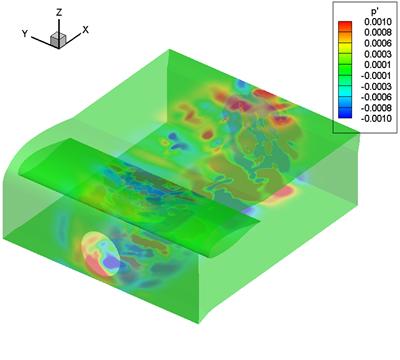Large-eddy simulations (LES) have been performed for the turbulent flow around an aircraft wing under the influence of jet flow from an engine to study installation effects. The flow field is computed by solving the compressible Navier-Stokes equations using an in-house high-order finite difference solver. The far field radiated sound is calculated from the LES data for near field sound sources with an integral solution of the Ffowcs Williams-Hawkings (FW-H) equation to investigate noise due to jet-airframe interaction. This study focuses on using LES to investigate the aerodynamic and aeroacoustic impacts due to the interaction of the jet flow with the wing. It is found that the flow is mainly two-dimensional near the leading edge of the wing and large spanwise structures are found underneath the wing. However further downstream, under the influence of the jet, three-dimensional flow features are developed. More turbulent structures are seen in the shear layer near the wing and their interaction with the wing causes surface pressure fluctuations, which results in increase in the radiated noise. For the current geometry, the jet does not hit the wing but is shifted towards the wing by a small angle (one degree) under the wing due to the low pressure region under the wing. When the flap is deployed, the jet hits the flap and is deflected away from the wing.

The high speed flow from the engine generates noise during the mixing process and interactions of turbulent structures. Noise generation by the jet interacting with the airframe, such as high-lift devices, is a fundamental problem affecting the design and performance of aircraft. Understanding the installation effect would help to design more efficient and more environmentally friendly aircraft. Flow mechanism and physics for noise generation by individual components have been studied extensively, using both experimental and numerical methods. However interactions between components are much more complicated. Both fly-over and wind tunnel tests have identified the global influence on noise radiated to the far field when different components are interacting with each other. However the underlying mechanisms are still open to questions and need further investigation.
For the current geometry, the jet does not hit the wing but is shifted towards the wing by a small angle (one degree) under the wing due to the low pressure region under the wing. When the flap is deployed, the jet hits the flap and is deflected away from the wing.